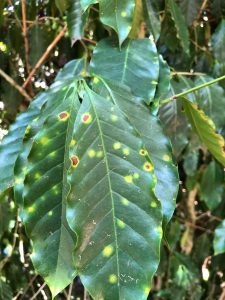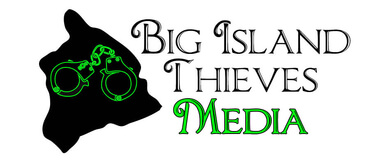 The Hawai`i Department of Agriculture (HDOA) today filed a request for a specific exemption from the U.S. Environmental Protection Agency (EPA) to allow Hawai`i coffee growers to use a fungicide to help manage coffee leaf rust (CLR), a fungus which is a serious threat to Hawai`i’s $56 million coffee industry. On March 3rd, Gov. David Ige delegated the authority to submit the EPA emergency application to Hawai`i Board of Agriculture (Board) chairperson, Phyllis Shimabukuro-Geiser.
The Hawai`i Department of Agriculture (HDOA) today filed a request for a specific exemption from the U.S. Environmental Protection Agency (EPA) to allow Hawai`i coffee growers to use a fungicide to help manage coffee leaf rust (CLR), a fungus which is a serious threat to Hawai`i’s $56 million coffee industry. On March 3rd, Gov. David Ige delegated the authority to submit the EPA emergency application to Hawai`i Board of Agriculture (Board) chairperson, Phyllis Shimabukuro-Geiser.
Later this month, the Board is also expected to consider expanding the CLR-infested areas designated in Interim Rule 20-1, regarding coffee quarantine measures that restricted the movement of coffee plants and plant parts and other CLR hosts from Maui and Hawai`i Island, to include Lana`i, and O`ahu. These actions are being taken due to CLR detections on Maui and Hawai`i Island in October 2020, and more recently on Lana`i and O`ahu.
The fungicide, Priaxor Xemium, is not labeled by the EPA for specific use on coffee plants, but it is allowed for use to control fungi on leafy vegetables, strawberries, tomatoes, soybeans, wheat and many other crops. The manufacturer of the fungicide notified HDOA last week that they support the review by EPA on the use of the product on coffee plants. Any use of Priaxor Xemium would not be allowable until EPA reviews and approves the application which could take up to 45 days. If the exemption is approved, the fungicide may be used for up to one year or until use on coffee plants is added to the product label by EPA and the product’s producer.
“Coffee leaf rust is a plant pathogen that cannot be eradicated once it takes hold so it’s important that we use all available tools, including the use of fungicides, to help manage the problem,” said Phyllis Shimabukuro-Geiser, chairperson of the Hawai`i Board of Agriculture. “We ask all those who have coffee plants to survey their plants and report possible infections so various management strategies may be implemented to minimize the impact on our important coffee industry.”
A multi-agency effort including HDOA, University of Hawai`i’s College of Tropical Agriculture and Human Resources (UH-CTAHR) and the USDA Daniel K. Inouye Pacific Basin Agricultural Research Center and the Hawai`i coffee industry have been ramping up efforts to battle the disease on several fronts.
In November 2020, HDOA implemented Interim Rule 20-1 that restricts the interisland movement of coffee plants, plant parts and other coffee-associated materials from Maui and Hawai`i Island. The Board has tentatively scheduled a virtual meeting for March 23rd to consider expanding the infested areas to include Lana`i and O`ahu and implementing the same restrictions on the movement of coffee plants, plant parts and other coffee-associated materials. Coffee growers and roasters have been notified by HDOA’s Plant Quarantine Branch (PQB) that the issue will be up for discussion and consideration by the Board. (Letter to grower and roasters attached.) Board meeting agendas are posted at least six days prior to the meeting on the State of Hawai`i Public Meeting calendar at: https://calendar.ehawaii.gov/calendar/ and at HDOA’s website at: https://hdoa.hawaii.gov/meetings-reports/
Other efforts to address the CLR infestations include importing disease-resistant coffee plants, developing integrated pest management strategies, best management practices, as well as requesting the use of Priaxor Xemium. A collaborative outreach program was also coordinated including radio public service announcements and informational posters.
In February 2021, Governor Ige declared that an emergency exists to Hawai`i’s coffee industry due to the effects of CLR. This declaration allowed organic coffee growers to file a request to the National Organic Certification Program to allow them to utilize non-organic products, such as Priaxor Xemium, and maintain their organic status.
CLR is a devastating coffee pathogen and was first discovered in Sri Lanka in 1869 and can cause severe defoliation of coffee plants resulting in greatly reduced photosynthetic capacity. Depending on CLR prevalence in a given year, both vegetative and berry growth are greatly reduced. There are multiple long-term impacts of CLR, including dieback, resulting in an impact to the following year’s crop, with estimated losses ranging from 30 percent to 80 percent.
Suspected CLR infestations should be reported to HDOA’s Plant Pest Control Branch at (808) 973-9525.
For more information about Priaxor Xemium use under the EPA exemption, please contact your local Pesticides Branch office at:
- Kauai: 808-241-7140
- Oahu: 808-973-9402
- Maui County: 808-873-3078
- Hawaii: 808-974-4143
For more information on CLR and the Hawaii coffee industry, go to:
- Coffee Education Website – UH-CTAHR: https://www.hawaiicoffeeed.com/HDOA Coffee Leaf Rust Advisory: https://hdoa.hawaii.gov/pi/files/2021/01/NPA-20-03-Coffee-leaf-rust1-21.pdf
- CLR Field Guide: https://hdoa.hawaii.gov/pi/files/2020/12/CLR-Public-field-guide-with-form11-20.pdf
- 2020-2021 Hawai`i Coffee Season Statistics (National Agricultural Statistics Service): https://www.nass.usda.gov/Statistics_by_State/Hawaii/Publications/Fruits_and_Nuts/Coffee-01-26-2021.pdf



